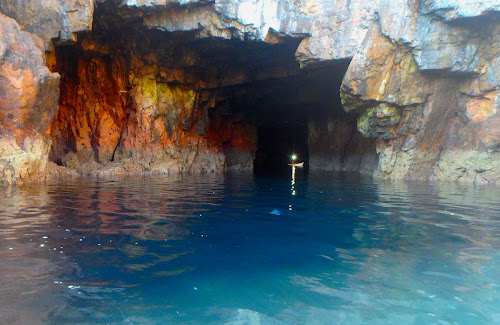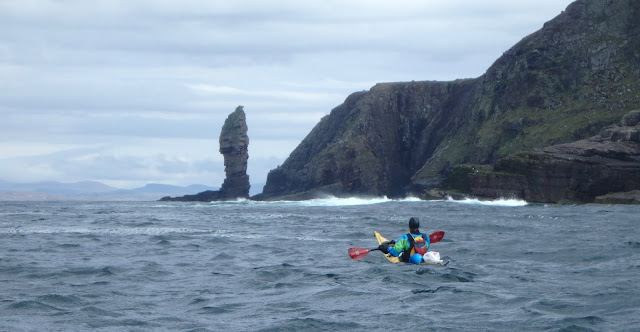Shetland is impressive, It really is! For several years I heard this said, and I'm not sure what finally convinced me to book a ferry, but I'm super happy, I did. Massive caves, super long tunnels, Geos (pronounced Gee-Oh) is a narrow, deep cleft in a rock face, tide races, exposure and commitment, big ocean swell, stunning wildlife, unsettled weather, oh and remote. I've only been to Shetland twice, May 2020 was to be the third time.
This blog is about my first-time sea kayaking in Shetland and a few quick-fix Performance Psychology top tips that I use, with my self and those I work with.
Blockbuster locations - My top three.
Papa
The
The gannets of Noss. I've been privileged to see gannets before in their thousands, spiralling above and nesting on islands. But never previously on a vertical rock face as well as doing battle with Great Skuas. It's like a world war 2 movie 'dog fight' and its happening right in front of you.
I guess it means I'll have to spend more time up there in 2021. Our next course dates or sign up for our newsletter to be the first to know.
Performance Psychology - quick fixes
The body and mind are linked, so if we can make a change with our physiology, it will influence or psychology and visa versa.
Forcing a smile helps to shake off the stress, by relaxing the facial muscles and returns us to the moment - we can't be anxious and smile!
Diaphragmatically breathing is one of the most potent techniques for reversing the stress response. When anxious, our bodies tend to revert to shallow, rapid, chest breathing. Doing so keeps us in fight or flight mode, which is a sympathetic shock. One technique is called box breathing:
Box breathing: in through your nose for x4, hold x4, out through the mouth for x4, hold for x4 and repeat.
Squeezing the paddle and creating tension in the body, then letting go, releases the pressure. Yul Brynner used to get stage fright, and he found that if he pushed really hard on a wall as if he wanted to knock it down, it helped calm his nerves, before a performance. The mind can perceive the sudden sense of relaxation within the body as the reduction of anxiety and stress.
Self -Talk such as "Don't think! Play!" is a super cue for paddlers when faced with pressure, in a tide race, for example. When you find yourself overthinking and if you can't cut off your thoughts altogether, choose one word or a short phrase that directs your focus and instructs your actions.
Useful "cue words," or Self-talk such as "I'm coming up" after a capsize and beginning to roll. "Look for the eddy" for a paddler in the main flow or "what's important now?" with the paddler that just swam. Captures what you're trying to accomplish and helps you stay focused or re-focus on the task at hand.
Beat The Stress Focus – is a useful way to pull techniques together, with a plan. B is for Breathing, T is self-Talk, S is Seeing – visualize/rehearse, and F is Focusing your attention. Working with this model or creating your own can be helpful, in providing control in challenging and dynamic environments.
Two web sites which provide further useful thought, are worth exploring. The first is based on an actors perspective of Managing Stage Fright, and the second is Performance under Pressure, from a medical perspective, which has a lot of additional links. It's one of the best sites I've found.
Which is greater?
If we now come back to my original question. Is your want more significant than your fear? If yes, from my perspective and experience, then the above techniques will be super productive. Hence the various methods are called 'coping strategies'. Your confidence has dropped, and you need to re-focus. Yes, they will need to be practised just like your stern rudder did.
If your fear is more significant than your need and want, then it could suggest you've moved too quickly, maybe missed a level and not consolidated skills, experience and knowledge. The concept of comfort zones can be useful to consider. Stepping down a level to what you feel is suitable, so you can progress at your rate and address what's important. Re-focusing can be very productive and motivating.
The fear needs to be understood and addressed for any progress to be made. Loss of control, then consider what would give you control back? For example, understanding tidal planning and the 50/90 guide? Do you ever choose where you paddle? The relationship and impact between swell, wind and current? Or for example, If its a fear of failing, ask your self: What aspect could you fail at? What's holding you back? What can you do about it? Remember the last blog about controlling the controlables?
How too
Cross-training can be really useful. For example, If its lack of flexibility, then consider yoga or pilates, if its stamina, how about taking up, running, cycling, using a rowing machine, flat water race training or going swimming. If it's becoming more dynamic with decision making and more short sharp burst of energy, consider white water paddling.
Keep in mind that progress could also be a sideways move. This would mean understanding the triggers and what creates the anxiety so that you can avoid these in the future. For example, when it gets windy, it's difficult to control my sea kayak. How strong is the wind? Then consider paddling under that wind strength and get a good understanding of the various weather forecast so you gain some further control.
A more in-depth approach would be to consider a few Cognitive Behavioural Therapy (CBT) sessions. This way you have an opportunity to develop further strategies to manage thoughts effectively, with a professional skilled in this area.
Our time is precious, so make sure it's worthwhile, enjoyable and what we want it to be. It's about investment. If we invest, we will reap the benefits. How much are you prepared to invest?
I hope to see you on the water very soon!
PS: Make sure you book a cabin, its worth it and adds to the whole experience

















